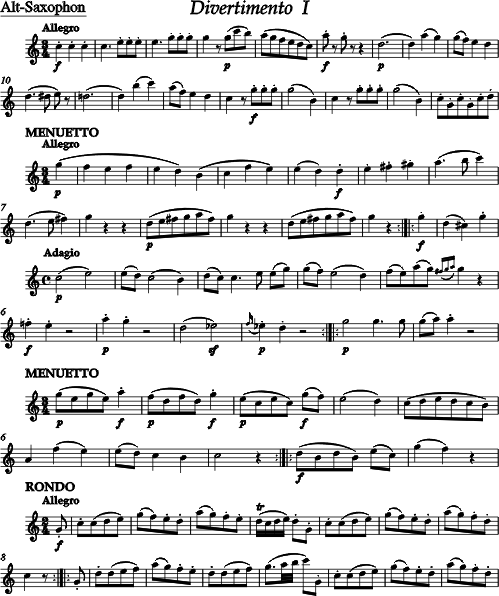WOLFGANG
AMADEUS
MOZART
DIVERTIMENTI
drei Saxophone (A - T - B)
DIVERTIMENTOS
three Saxophones (A - T - B)
DIVERTIMENTOS
trois Saxophones (A - T - B)
DIVERTIMENTI
tre Sassofoni (A - T - B)






Editio Alto stellt dem Kammermusikfreund eine Reihe
von Werken in praktischer Ausgabe zur Verfügung, deren Schwierigkeitsgrad
zum großen Teil auch von Laienspielern zu bewältigen sind.
Mit Absicht werden auch solche Werke vorgestellt, die von der üblichen
Besetzung abweichen und deshalb oft weniger bekannt sind.
Eine solche "unübliche" Besetzung entsteht manchmal durch Zufall, wenn
zum Beispiel zum Streichquartett-Abend ein Spieler nicht erscheint. In
dem sachkundigen und nützlichen Büchlein "Das stillvergnügte Streichquartett"
von Ernst Heimeran und Bruno Aulich gibt es ein Kapitel: "Was spielt man,
falls....."
Falls das Cello nicht kommt, ist der Fall besonders heikel. Die Literatur
für zwei Violinen und Viola ist spärlich. Die hier in Bearbeitung für
diese Besetzung vorgelegten Trios von Mozart werden deshalb besonders
willkommen sein.
Für die von Mozart vorgesehene Besetzung für drei Bassetthörner gibt es
kein Autograph, nur eine briefliche Erwähnung von Constanze Mozart an
den Verleger André.
Die ersten Ausgaben der 25 Stücke sind also bereits Bearbeitungen. Die
Zusammenfassung zu 5 Divertimenti zu je 5 Sätzen entspricht der üblichen
Satzfolge dieser Gattung und fügt sich gewissermaßen von selbst. Durch
die zahlreichen Bearbeitungen, zunächst für 2 Klarinetten und Fagott,
dann für 2 Violinen und Violoncello, auch für Klavier und Streicher, fanden
die kleinen Meisterwerke große Verbreitung und wurden sehr beliebt.
Wie zauberhaft sie in der Originalbesetzung für 3 Bassetthörner klingen,
bekommt man nur selten zu hören. Eine CD-Einspielung ist (im Rahmen der
W.A. Mozart Gesamtausgabe) bei Philips erschienen. Dem Zauber dieses einheitlichen,
zusammengefaßten Klangbildes so nahe wie möglich zu kommen, wurde hier
für die dritte Stimme kein Baßinstrument, sondern die Viola gewählt. Die
Klangfarbenkluft zwischen den beiden oberen und der Unterstimme ist damit
überwunden.
Editio Alto presents to the friend of chamber music
a series of pieces in a practicable edition, setting the degree of difficulties
to a level that - in most cases - can be mastered also by laymen.
One focus of the publisher clearly was to introduce works that deviate
from the usual instrumentation and, for exactly this reason, are only
little known.
Very often such an "unusual" instrumentation is born out of pure chance:
for example, when one member of a string quartet for some reason does
not show up. In the excellent and useful little book by Ernst Heimeran
and Bruno Aulich, "The Cheerful String Quartet"(*), one of the chapters
is headed with: "What do we play in case...." (**).
In case the cello does not show up the situation is particularly tricky.
Literature for two violins and viola is scarce. Thus Mozart´s Trios, in
this edition scored for these instruments, will be only too welcome..
In Mozart´s autograph there is no hint regarding the instrumentation intended
by him - three basset horns. Constanze Mozart, however, mentioned it in
a letter to the publisher André.
So, even the first publications of these 25 pieces were arrangements.
When divided into 5 divertimenti with 5 movements each, the results correspond
to the usual sequence of this type of music and, so to speak, fall into
place easily. Due to the variety of arrangements - for 2 clarinets and
bassoon, 2 violins and cello and also piano and strings - these little
master pieces were widely spread and became very popular.
The chances to hear this music in its enchanting original cast - three
bassett horns - are rare. One CD has been published by Philips (included
in the complete edition of W.A. Mozart´s works).
In order to come as close as possible to the magic of this well-balanced
and concentrated sound, the viola was chosen for the third part instead
of a bass instrument. In this way the gap in sound colours between the
two high parts and the lowest part has been closed.
(*) German original: "Das Stillvergnügte Streichquartett"
(**) German original: "Was spielt man, wenn...."
Fenster schließen
- Close Window - Fermer la fenêtre - Chiudi la finestra